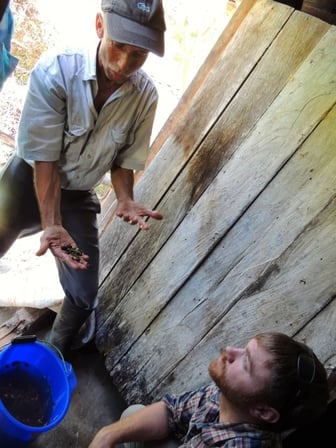Since Saturday, the Sustainable Harvest® Colombia team has been traveling with four graduate students from Stanford University’s d.School: a biologist, an economist, and two mechanical engineers. Part of a partnership with Stanford's d.School that we discuessed in recent blog post. All four of them are part of Stanford’s Design for Extreme Affordability Course, which pits together bright minds across multidisciplinary fields to bring innovative, cost effective design solutions to those that need it most in the world. As me mentioned in an earlier post, Sustainable Harvest® has partnered with the d.School to bring students from the course to the world of coffee. The team of four has spent the last week with us visiting farms, listening to their needs and producers, and assessing critical points of coffee processing that directly impact quality: depulping and drying.
 The trip has been a profound learning experience not only for the students who are new to coffee, but for us too. The depth with which we discussed each topic with producers, technicians and others, has shown me that there is still so much work to do in coffee, especially in sharing information and the standardizing best practices for all of the coffee processes. For example, we know that fermentation is critical to cup quality, but often producers have no defined standard to determine when fermentation is complete--most use sight, smell, and touch, but simple tools like a blood sugar meter, thermometer, and pH strips can make much more accurate measurements.
The trip has been a profound learning experience not only for the students who are new to coffee, but for us too. The depth with which we discussed each topic with producers, technicians and others, has shown me that there is still so much work to do in coffee, especially in sharing information and the standardizing best practices for all of the coffee processes. For example, we know that fermentation is critical to cup quality, but often producers have no defined standard to determine when fermentation is complete--most use sight, smell, and touch, but simple tools like a blood sugar meter, thermometer, and pH strips can make much more accurate measurements.
How should we convey information like this so it is truly adopted by producers? Even if the Stanford students are successful in creating an affordable, new way to dry coffee for maximum quality, it will be useless if producers aren’t motivated to adopt it. They need to know how step by step to use the new tools and how complement them with good drying practices. The steps need to be clear, visual, and readily available (using videos, manuals, posters on the wall, and more) so that the new practices can be converted into habits and we can achieve the impact we have set out to achieve.
In specialty coffee we see innovation every day. And yet, so much still needs to be done for producer livelihoods. Commodity prices for coffee remain low, and only with low-cost, high-impact solutions to improving quality can deliver the change we seek. This is the right time not only to innovate, but to create alternatives that are truly implementable. This is why the last week has been spent on the crucial task of listening and reflecting on all of the possible variables of an innovation-- resources, affordability, production, distribution, end users, dissemination of information, adoptability, and more.
This week I have had the opportunity to see my work in a different way--to see new colors and shapes, and go outside of the box of my every day life in the specialty coffee industry. The Design for Extreme Affordability class ends in 12 weeks--ample time for much more discovery.



.png)
